
Friesner R.A. (ed.) - Advances in chemical physics, computational methods for protein folding (2002)(en)
.pdf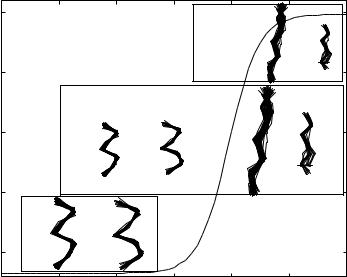
insights into specific problems in protein folding |
45 |
|
7 |
|
|
|
= −1.0 kcal/mol |
|
|
|
|
|
|
|
β |
Turn/ |
|
|
|
|
|
|
loop |
|
|
|
6.5 |
|
|
|
|
|
|
|
|
|
= −2.0 kcal/mol |
|
|
|
|
> |
6 |
|
|
|
|
|
|
g |
|
|
|
|
|
|
|
<R |
|
310 |
α |
|
β |
Turn/ |
|
|
|
|
|
||||
|
|
|
|
|
|
loop |
|
|
5.5 |
= −4.0 kcal/mol |
|
|
|
|
|
|
|
|
|
|
|
||
|
5 |
310 |
α |
|
|
|
|
|
|
|
|
|
|
|
|
|
−6 |
−5 |
−4 |
−3 |
−2 |
−1 |
0 |
|
|
Hydrogen bond ( ) strength in kcal/mol |
|
|
|||
Figure 1. Dependence of the radius of gyration hRgi for polyalanyl chain of length n = 7 [64] on the hydrogen bond length E. As E increases, compact conformations are populated preferentially. The transition from the extended conformations at higher values of E to the contracted conformations occurs rather cooperatively in an apparent ‘‘two-state’’ manner. The radius of gyration is computed using a coarse-grained thermally weighted density of states (see Ref. 64 for details). Conformations that make the most significant contributions at different values of E are also shown.
sequences encode for foldable protein structures, which for functional purposes are constrained to have specific physical characteristics. How do viable protein structures emerge from the dense sea of sequence space [66]? The extraordinary thinning of the sequence space as one gets to the structure space may be understood purely on the basis of accepted physical properties of proteins. To this end, two interrelated physical features of folded proteins must be taken into account. (i) Native proteins are compact. (ii) The interior of proteins consists mainly of hydrophobic residues, while the hydrophilic residues are typically found on the surface. This gives rise to a maximum number of favorable interactions making the native state very low in energy.
Lattice models are remarkably useful in answering the conceptual question posed above. To infer the sequence to structure mapping, we performed an exhaustive enumeration of all self-avoiding conformations for the sequences confined to cubic lattice with N ¼ 15 [44]. The RB model has been used in the energy function with the parameters B0 ¼ 0:1 and B ¼ 1. Protein-like structures are not only compact but also have low energy. We first computed the

46 |
d. thirumalai, d. k. klimov, and r. i. dima |
number of compact structures (CSs) for a given N; CN , (CS). The number of CSs, in its most general form, is expected to scale as
Nd 1 |
ð6Þ |
CN ðCSÞ ’ ZN Z1 d Ngc 1 |
where ln Z is the conformational free energy (in units of kBT), Z1 is the surface fugacity, d is the spatial dimension, and gc measures possible logarithmic corrections to the free energy. The number of natural protein folds is limited (perhaps a few thousands), and their number is expected to grow at rates much smaller than those predicted in Eq. (2). To explore this we calculated by exact enumeration the number of minimum energy structures (MES), CN (MES), as a function of N.
We define MES as those conformations whose energies lie within the energy interval above the lowest energy E0, corresponding to the native state. Several values for (1.2 or 0.6) were used to ensure that no qualitative changes in the results are observed. We also tested another definition for ¼ 1:3jE0 tB0j=N, where t is the number of nearest-neighbor contacts in the ground state. It is worth noting that in the latter case increases with N. Nevertheless, both definitions yield equivalent results. The computational technique involves exhaustive enumeration of all self-avoiding conformations for N 15 on a cubic lattice. We calculated the energies of all conformations according to Eq.
(1) and then determined the number of MES and CS. Each quantity, such as CN (MES), CN (CS), the lowest energy E0, or the number of nearest-neighbor contacts t in the lowest energy structures, is averaged over 30 sequences. To test the reliability of the computational results, an additional sample of 30 RB sequences was generated. Note that in the case of C(MES) we computed the quenched average as CN ðMESÞ ¼ exp ½ ln ½cðMESÞ&&, where c is the number of MES for one sequence.
The number of MES C(MES) is plotted as a function of the number of residues N in Fig. 2 for ¼ 0.6. A pair of squares for a given N represents C(MES) computed for two independent runs of 30 sequences each. For comparison, the number of self-avoiding walks C(SAW) and the number of CS C(CS) are also plotted in this figure (diamonds and triangles, respectively). As expected on general theoretical grounds, C(SAW) and C(CS) grow exponentially with N, whereas the number of MES C(MES) exhibits drastically different scaling behavior. There is no variation in CN (MES) (normally, associated with the variation of shapes of compact structures) and its value remains steady within the entire interval of N starting with N ¼ 7. We find (see Fig. 2) that CN (MES) 101. This result further validates our earlier finding for the twodimensional model [46]. The results strongly suggest that CN (MES) scales only as ln N. Thus, the dual restriction of compactness and low energy of the native states may impose an upper bound on the number of distinct protein folds.
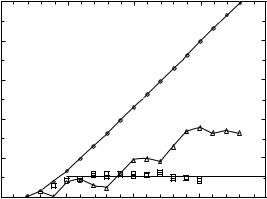
insights into specific problems in protein folding |
47 |
|
1010 |
|
|
|
|
|
|
MES: B0 = −0.1, ∆ = 0.6 |
C (SAW) |
|
|
|
|
|
|
||
|
108 |
quenched averaging |
|
|
|
of structures |
|
cubic lattice |
|
|
|
106 |
|
|
|
|
|
|
|
|
C (CS) |
|
|
Number |
104 |
|
|
|
|
|
|
|
|
||
102 |
|
|
|
|
|
|
|
|
C (MES) |
|
|
|
100 |
5 |
10 |
15 |
20 |
|
0 |
||||
|
|
|
N |
|
|
Figure 2. Scaling of the number of MES CN (MES) (squares) on a cubic lattice. The data are obtained for B0 ¼ 0.1 and ¼ 0:6. The pairs of squares for each N represent the quenched averages for different samples of 30 RB sequences. The number of compact structures CN (CS) and selfavoiding conformations CN(SAW) are plotted to highlight the dramatic difference in scaling behavior. It is clear that C(MES) remains practically flat; that is, it grows no faster than ln N.
A.Designability of Protein Folds
The computations described above indicate that minimal restrictions on the structures (compactness and low energies) make the structure space sparse. Consequently, each basin of attraction in the structure space must contain numerous sequences [66]. The way these sequences are distributed among the very slowly growing number (with respect to N) of conformations—that is, the density of sequences in structure space—is another important question. Li et al. [67] considered a three dimensional cubic lattice proteins with N ¼ 27. By using the HP model and restricting themselves to only maximally compact structures as tentative candidates for protein native states, they showed that certain folds (i.e., structures) accommodate much larger number of sequences (see Fig. 3a) than the others. In one example, they found the NBA (the structure) that serves as a ground state for 3794(!) (when the total number is 227) sequences and, hence, was considered most designable. The precise distribution of sequences among NBAs is a function of the particular energy function.
An important conclusion of Li et al. [67] is that one can define, at least operationally, a designability index for every fold found in PDB. The structural characteristics of a given fold determine its designability. Several authors have suggested that if the fold has even an approximate symmetry, then it would be more designable [67,68]. This might explain the preponderance of TIM barrel
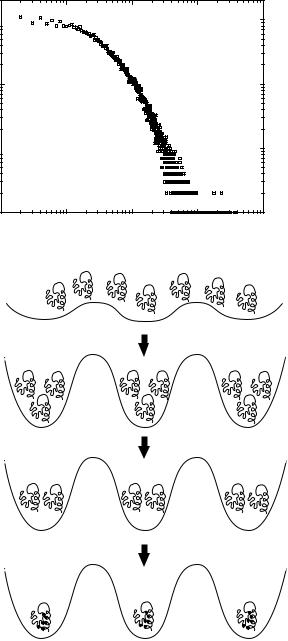
48 |
d. thirumalai, d. k. klimov, and r. i. dima |
Number of structures
1000 

100
10 
1 |
|
|
|
|
1 |
10 |
100 |
1000 |
10000 |
Ns
(a)
Sequence space
Sequences which encode MES
Foldable sequences
Biologically competent sequences
(b)

insights into specific problems in protein folding |
49 |
structures. If the symmetry argument is extended to RNAs, then we would conclude that certain symmetries should be hidden at the sequence level of mRNAs and ultimately the genes themselves encoding a given protein [44].
Because the number of NBA for the entire sequence space is very small, it is likely that proteins could have evolved randomly. Natural folds must correspond to one of the native basins of attraction in the structure space so that many sequences have these folds as the native conformations. In other words, natural protein folds, especially those with approximate symmetries, represent highly designable structures [67]. Further support for these ideas comes from the study of Lindgard and Bohr [69]. These authors showed that among maximally compact structures there are only very few folds that have protein-like characteristics. It was also estimated that the number of distinct protein folds is on the order of 103. Thus, each fold can be designed by many candidate sequences. However, there is also evolutionary pressure for sufficiently rapid folding to avoid aggregation. This kinetic requirement further restricts the possible sequences that can serve as biologically viable proteins (Fig. 3b).
V.PROTEIN FOLDING MECHANISM
Using lattice models with side chains we describe the most commonly found scenarios observed in protein folding. Because this topic has been subject of numerous reviews [6,9–12,41], we will stress a few points that are relevant in considering chaperonin-mediated protein folding that is discussed in Section VII.
A.Two-State Folders
Thermodynamics for the sequence with the native state shown in Fig. 4 with the contact interaction potentials Bij taken from Table III of Ref. 54 reveals that it folds cooperatively in an apparent two-state manner. This is also reflected in the thermal distribution of the overlap function values h(w) at the folding transition temperature TF (Fig. 4). A nearly bimodal distribution of h(w) with the peaks at w 9 0:2 (NBA) and w 0.6 (unfolded state) is observed. There is also nonnegligible contribution from the intermediate values of w representing partially folded structures. Experiments that probe in more detail the thermal unfolding of proteins are beginning to reveal the possible importance of these
Figure 3. (a) A log–log plot of the histogram for number of structures with respect to the number of associated sequences Ns for 27-mer maximally compact cubic lattice conformations [67]. The plot illustrates a dramatic heterogeneity among structures in terms of their ability to encode protein sequences. (b) Schematic illustration of the mapping of vast sequence space onto the limited number of protein folds. This mapping involves drastic reduction in sequence space as polypeptide sequences evolve into functionally competent proteins.
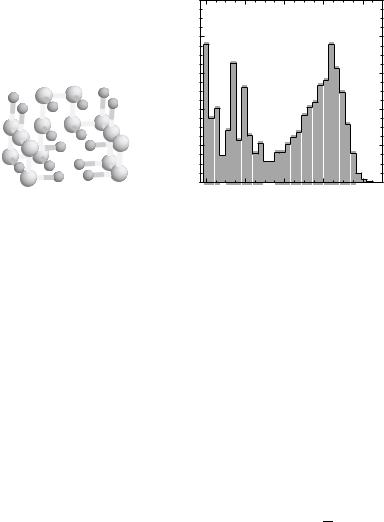
50 |
d. thirumalai, d. k. klimov, and r. i. dima |
0.10 |
|
|
|
|
0.08 |
|
|
|
|
0.06 |
|
|
|
|
h (χ) |
|
|
|
|
0.04 |
|
|
|
|
0.02 |
|
|
|
|
0.00 |
|
|
|
|
0.0 |
0.2 |
0.4 |
0.6 |
0.8 |
|
|
χ |
|
|
Figure 4. Native structures of sequences A generated using [126] is shown in the left panel. Backbone and side-chain beads are shown in light and dark gray, respectively. Native conformation is compact and has a well-defined hydrophobic core. The figure is generated using program RasMol [126]. The right panel displays the thermal distribution of states hðwÞ calculated at T TF for sequence A. hðwÞ is approximately bimodal so that only NBA ðw 90:2Þ and unfolded state Uðw 0:6Þ are significantly populated. Although small, the population of intermediate states nevertheless makes a sizable contribution to thermodynamics (affecting mainly cooperativity of folding).
conformations [70]. Due to substantial contribution from the partially folded structures, thermal unfolding cannot be quantitatively described as two-state.
The folding kinetics can be probed using the distribution of the first passage times, t1i. Several hundred ( 600) folding events are used to obtain the distribution of t1i, from which the fraction of unfolded molecules PuðtÞ may be readily obtained. In addition to PuðtÞ, we have computed the time dependence of the radius of gyration hRgðtÞi, where the average is taken over 100 folding trajectories.
The sequence, whose native state is shown in Fig. 4, displays two-state
kinetics for the temperatures T 0:8TF; that is, PuðtÞ expð t Þ, where tF is
tF
the folding time. To probe the sequence of events en route to the native conformation, we computed hRgðtÞi, which reveals two stages in collapse. Initial rapid burst phase is followed by a gradual chain compaction (Fig. 5). The overall collapse time tc is associated with the second characteristic time. From the approach to the native conformation we draw the following general conclusions regarding two-state folders:
(a) The ratio tF=tc for two-state folders is typically less than 10. This is consistent with the fast-folding experiments on several two-state folders, which
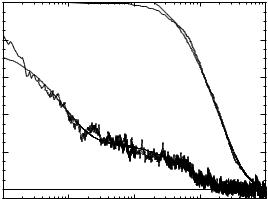
insights into specific problems in protein folding |
51 |
|
1.0 |
|
|
|
|
|
0.8 |
|
|
|
Pu (t) |
(t) |
0.6 |
|
|
|
|
u |
|
|
|
|
|
|
|
|
|
|
|
>,P |
|
|
|
|
τF |
(t) |
|
|
|
|
|
0.4 |
|
|
|
|
|
g |
|
|
|
|
|
<R |
|
|
|
τC |
|
|
|
|
|
|
|
|
0.2 |
|
|
|
|
|
|
<Rg (t) > |
|
|
|
|
0.0 |
|
|
|
|
|
103 |
104 |
105 |
106 |
107 |
|
|
|
t , MCS |
|
|
Figure 5. The time dependence of the normalized radius of gyration hRgðtÞi and the fraction of unfolded molecules PuðtÞ for sequence A at T ¼ 0.94TF . Data are averaged over 100 [for hRgðtÞi] and 600 [for PuðtÞ] trajectories. PuðtÞ decays exponentially with the time scale tF ¼ 2:07 106 MCS. The approach of hRgðtÞi to equilibrium is biexponential with the times scales 0:083 106 MCS and 0:698 106 MCS. The first time scale is due to extremely rapid burst-phase partial collapse. The second time scale, which is associated with the collapse time tc, corresponds to the final compaction. The ratio tF =tc is approximately 3.0.
show that proteins rapidly collapse and reconfigure themselves to reach the native state. For the sequence in Fig. 4, tF=tc 3. This ratio is in the range 5–10 for proteins.
(b) Analysis of the collapsed conformations shows that they are native-like; that is, the initial collapse in two-state folders is ‘‘specific’’ with very few nonnative interactions present. The overall scheme for reaching the NBA for two-state folders, which was predicted using theoretical arguments, is
U ! fINg ! N |
ð7Þ |
where fINg is a collection of native-like structures. Fast-folding experiments on cyt-c and tendamistat [71] have been interpreted using this picture. Because the initial collapse is specific, the ensemble of native-like intermediates can be likened to an ‘‘on-pathway’’ intermediate. Lattice simulations (without side chains) using Go model have come to a similar conclusion [72]. In the Go model the only possible nonnative ‘‘interaction’’ comes from the topological entanglements, which are highly unlikely given the relatively small (48-mer) welldesigned sequence.
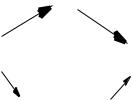
52 |
d. thirumalai, d. k. klimov, and r. i. dima |
|
B. Moderate Folders, Topological Frustration, and |
|
Kinetic Partitioning Mechanism |
Many |
qualitative aspects of the folding kinetics of moderate folders can |
be understood in terms of the concept of topological frustration [10]. On average, about 55% of residues in proteins are hydrophobic, and their density along the sequence is roughly constant. As a result, on any local length scale there is a propensity for the hydrophobic residues to form tertiary contacts (structures) under folding conditions; that is, proximal residues adopt preferred structures. The assembly of the resulting structures would most likely be in conflict with the global native fold. The incompatibility of the low free-energy structures on local and global scales leads to a phenomenon called topological frustration. Topological frustration is an intrinsic property of all foldable sequences and arises due to the polymeric nature of proteins and the heterogeneity of amino acids. It follows that even the Go model is topologically frustrated because residue connectivity can render certain favorable local structure incompatible with the global fold. An important physical outcome of topological frustration is that the free-energy folding landscape is rough, consisting of many minima that are separated by barriers of varying heights.
One of the principal consequences of topological frustration is that the folding kinetics follows the kinetic partitioning mechanism (KPM) [10]. Imagine an ensemble of unfolded molecules in search of the native conformation (Fig. 6). Due to the heterogeneity of folding pathways, a fraction of molecules, , would reach the NBA (or N) rapidly without being kinetically trapped in the low-lying free-energy competing basins of attraction (CBA). The remaining fraction,
I N
Φ
{U} N
1 − Φ
{I NSC} { I i }
{ I i }
Figure 6. The sketch of the protein folding pathways. The fast (upper) folding pathway includes the formation of native-like collapsed states {IN}, which rapidly convert into the native state N. The fraction of protein molecules, folding along this pathway, is . For two-state folders,1. The lower track (followed by 1 molecules) represents slow pathway(s), which fold by a three-stage kinetic mechanism. At the first stage, nonspecific collapse species INSC form, which later convert into a collection of discrete native-like intermediates {Ii}. The transition from {Ii} to the native state is slow and represents the rate-limiting step in the slow pathway. The degree of heterogeneity in the folding pathways depends on the sequence and external conditions.
insights into specific problems in protein folding |
53 |
(1 ), would be trapped, and only on longer time scales would |
thermal |
fluctuations enable the chain to reach the NBA through an activated process. The value of the partition factor depends on the sequence and external conditions. Thus, topological frustration leads to a separation of the initial ensemble of denatured molecules into fastand slow-folding phases (Fig. 6). For two-state folders, which have a funnel-like free energy landscape, ¼ 1.
According to the KPM PuðtÞ [see Eq. (3)] is given by |
|
|
|
|||||||
ð Þ ¼ |
|
tN |
þ X |
|
tk |
|
ð |
Þ |
||
Pu t |
exp |
|
t |
|
ak exp |
|
t |
|
8 |
|
|
|
|
|
|
||||||
k
where tN is the time scale for reaching the native state by the fast (direct) process (presumably by the nucleation-collapse), and tk is the time scale for indirect folding pathways, in which the native state is reached after escaping a local freeenergy minimum (trap) k. Prefactors ak are related to the ‘‘volumes’’ associated with the kth CBA. Thus, folding trajectories can be divided into those that reach the native conformation rapidly (their fraction or partition factor is ) and those that follow indirect off-pathway routes (Fig. 6).
The validity of the KPM has been demonstrated in several protein-like models beginning with the studies of Guo and Thirumalai [73]. More importantly, refolding experiments, on lysozyme [74] and large ribozymes [75] have confirmed the KPM. Using interrupted folding experiments, Kiefhaber [74] was the first to show that 0:15 in lysozyme. Subsequent studies of lysozyme by Dobson and coworkers [76] show that 0:25 in lysozyme. The difference is presumably due to changes in folding conditions. Perhaps the most direct demonstration of the validity of the KPM comes from the single-molecule FRET measurements on the L-21 Sca I ribozyme [77]. The results of these experiments analyzed by us showed that 0:06, which is consistent with the estimates from ensemble measurements. These experiments show that KPM offers an unified picture of folding for a class of proteins and RNA [78].
VI. DISULFIDE BONDS IN FOLDING
A.Refolding of BPTI
Bovine pancreatic trypsin inhibitor (BPTI), a small protein with 56 amino acid residues (Fig. 7), is the first one for which a detailed map of the refolding pathways was deciphered. The native state of BPTI contains three disulfide (S–S) bonds formed between six Cys residues. Native state is specified by [30–51; 5–55;14–38] bonds. This notation indicates that Cys30 forms an S–S bond with Cys51, and so on. Reduction of the S–S bonds unfolds BPTI. By using S–S bond formation as a ‘‘progress variable,’’ Creighton [79–83] devised ingenious methods to trap the disulfide-bonded intermediates along the folding pathway.
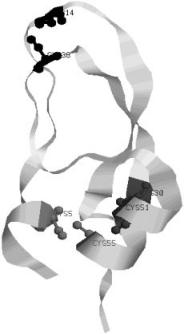
54 |
d. thirumalai, d. k. klimov, and r. i. dima |
Figure 7. See also color insert. The native-state conformation of the bovine pancreatic trypsin inhibitor (BPTI). The figure was produced with the program RasMol 2.7.1 [126] from the PDB entry 1bpi. There are three disulfide bonds in this protein: Cys5–Cys55 shown in red, Cys14–Cys38 shown in black, and Cys30–Cys51 shown in blue. The corresponding Cys residues are in the ball-and-stick representation and are labeled. The two helices (residues 2–7 and 47–56) are shown in green.
The refolding pathways were described in terms of the nature of the intermediates that accumulate during folding. There are 75 distinct intermediates containing one or more disulfide bonds that can be formed from six Cys residues. On the time scale of the experiments, Creighton discovered that only eight intermediates could be detected. These experiments were among the earliest to show that in the folding reaction only a small number of partially folded intermediates accumulates.
The most surprising discovery made by Creighton [79–83] was that in the refolding of BPTI, three non-native states—namely, the intermediates with disulfide bonds not present in the native state—are well-populated. More importantly, two of the non-native species, [30–51;5–14] and [30–51;5–38], are involved in the productive pathway; that is, folding proceeds through either of these two kinetically equivalent intermediates. The detection method employed by Creighton involves quenching the folding reaction using chemistry to stop the reaction. To isolate only the intermediate that would naturally occur in the refolding process, the quench rate must exceed rates of formation of other products. The chemistry of the quench method determines the time required to stop the reaction from progressing. Creighton’s findings were challenged by
